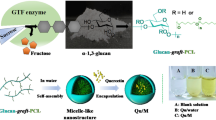Abstract
pH sensitive polymer systems can be utilized as smart nanocarriers to deliver hydrophobic drugs specifically to solid tumors or to acidosis-affected rheumatic joints. In this study, a poly(L-aspartic acid-graftimidazole)-block-poly(ethylene glycol) (P(Asp-g-Im)-PEG) block copolymer was synthesized as a pH sensitive nanocarrier targeting acidic pH environments. The polypeptide P(Asp), which was used as a backbone for the hydrophobic block, was synthesized by ring opening polymerization with N-carboxylanhydride (NCA) of β-benzyl-aspartic acid. PEG was included as the hydrophilic block and the polymer was functionalized with imidazole groups to confer pH sensitivity. The prepared P(Asp-g-Im)-PEG is zwitterionic with a pI 6.5; 60% of the available carboxyl groups of P(Asp)-PEG were substituted by imidazole groups. Furthermore, the potentiometric titration curve of P(Asp-g-Im)-PEG demonstrated a broad buffer zone. The micelles prepared from P(Asp-g-Im)-PEG showed pH dependent critical micelle concentrations (CMC), particle sizes, zeta potentials, and morphologies.

Similar content being viewed by others
References
T. J. Deming, Prog. Polym. Sci., 32, 858 (2007).
G. S. Kwon, M. Naito, K. Kataoka, and M. Yokoyama, Colloids Surf. B: Biointerfaces, 2, 429 (1994).
E. R. Welsh and D. A. Tirrell, Biomacromolecules, 1, 23 (2000).
K. Kataoka, A. Harada, and Y. Nagasaki, Adv. Drug Deliv. Rev., 47, 113 (2001).
A. Lavasanifar, J. Samuel, and G. S. Kwon, Adv. Drug Deliv. Rev., 54, 169 (2002).
K.T. Oh and E. S. Lee, Polym. Adv. Technol., 19, 1907 (2008).
D. A. Herold, K. Keil, and D. E. Bruns, Biochem. Pharmacol., 38, 73 (1989).
C. Allen, D. Maysinger, and A. Eisenberg, Colloids Surf. B: Biointerfaces, 16, 3 (1999).
R. J. Hunter, Foundations of Colloid Science, Oxford University Press, New York, 1991.
K. Osada, R. J. Christie, and K. Kataoka, Journal of The Royal Society Interface, 6, S325 (2009).
J. M. Anderson, K. L. Spilizewski, and A. Hiltner, in Biocompatibility of Tissue Analogs, D. F. Williams, Ed., CRC Press, Boca Raton, 1985.
G. Gaucher, M.-H. Dufresne, V. P. Sant, N. Kang, D. Maysinger, and J.-C. Leroux, J. Control. Release, 109, 169 (2005).
M. Yuan and X. Deng, Eur. Polym. J., 37, 1907 (2001).
H. R. Kricheldorf, α-Aminoacid-N-carboxyanhydrides and related materials, Springer, New York, 1987.
G. Pratesi, G. Savi, and G. Pezzoni, Bri. J. Cancer, 52, 841 (1985).
M. Yokoyama, M. Miyauchi, N. Yamada, T. Okano, Y. Sakurai, K. Kataoka, and S. Inoue, Cancer Res., 50, 1693 (1990).
Y. Bae, W.-D. Jang, N. Nishiyama, S. Fukushima, and K. Kataoka, Mol. Biosyst., 1, 242 (2005).
Y. Bae, N. Nishiyama, S. Fukushima, H. Koyama, M. Yasuhiro, and K. Kataoka, Bioconjug. Chem., 16, 122 (2005).
E. S. Lee, K. Na, and Y. H. Bae, J. Control. Release, 91, 103 (2003).
E. S. Lee, K. Na, and Y. H. Bae, Nano Lett., 5, 325 (2005).
E. S. Lee, K. Na, and Y. H. Bae, J. Control. Release, 103, 405 (2005).
E. S. Lee, K. T. Oh, D. Kim, Y. S. You, and Y. H. Bae, J. Control. Release, 123, 19 (2007).
E. S. Lee, H. J. Shin, K. Na, and Y. H. Bae, J. Control. Release, 90, 363 (2003).
D. Kim, E. S. Lee, K. T. Oh, Z. G. Gao, and Y. H. Bae, Small, 4, 2043 (2008).
G. M. Kim, Y. H. Bae, and W. H. Jo, Macromol. Biosci., 5, 1118 (2005).
E. Cesaroni, M. Scarpelli, N. Zamponi, G. Polonara, and M. Zeviani, Pediatr. Neurol., 41, 131 (2009).
M. Ferrari, Nat. Rev. Cancer, 5, 161 (2005).
D. B. Leeper, et al., Int. J. Radiat. Oncol. Biol. Phys., 28, 935 (1994).
E. Paleolog and R. Fava, Springer Seminars in Immunopathology, 20, 73 (1998).
A. Patchornik, A. Berger, and E. Katchalski, J. Am. Chem. Soc., 79, 5227 (1957).
K. G. Myun, B. Y. Han, and J. W. Ho, Macromol. Biosci., 5, 1118 (2005).
S. Zalipsky and G. Barany, J. Bioact. Compat. Polym., 5, 227 (1990).
E. A. Lysenko, T. K. Bronich, E. V. Slonkina, A. Eisenberg, V. A. Kabanov, and A. V. Kabanov, Macromolecules, 35, 6351 (2002).
G. Kwon, M. Naito, M. Yokoyama, T. Okano, Y. Sakurai, and K. Kataoka, Langmuir, 9, 945 (1993).
G. S. Kwon and T. Okano, Adv. Drug Deliv. Rev., 21, 107 (1996).
G. Mohajer, E. Lee, and Y. Bae, Pharmaceut. Res., 24, 1618 (2007).
B. R. Lee, K. T. Oh, H. J. Baik, Y. S. Youn, and E. S. Lee, Int. J. Pharm., 392, 78 (2010).
N. Kanayama, S. Fukushima, N. Nishiyama, K. Itaka, W.-D. Jang, K. Miyata, Y. Yamasak, U.-I. Chung, and K. Kataok, Chem. Med. Chem., 1, 439 (2006).
Y. Liu and T. M. Reineke, Bioconjug. Chem., 18, 19 (2006).
A. V. Kabanov, I. R. Nazarova, I. V. Astafieva, E. V. Batrakova, V. Y. Alakhov, A. A. Yaroslavov, and V. A. Kabanov, Macromolecules, 28, 2303 (1995).
M. Wilhelm, C. L. Zhao, Y. Wang, R. Xu, M. A. Winnik, J. L. Mura, G. Riess, and M. D. Croucher, Macromolecules, 24, 1033 (1991).
S. Pal and S. P. Moulik, J. Lipid. Res., 24, 1281 (1983).
K. T. Oh, et al., Int. J. Mol. Sci., 10, 3776 (2009).
Author information
Authors and Affiliations
Corresponding author
Additional information
These authors equally contributed to this work.
Rights and permissions
About this article
Cite this article
Kim, J.H., Oh, Y.T., Lee, K.S. et al. Development of a pH-sensitive polymer using poly(aspartic acid-graft-imidazole)-block-poly(ethylene glycol) for acidic pH targeting systems. Macromol. Res. 19, 453–460 (2011). https://doi.org/10.1007/s13233-011-0502-z
Received:
Revised:
Accepted:
Published:
Issue Date:
DOI: https://doi.org/10.1007/s13233-011-0502-z




